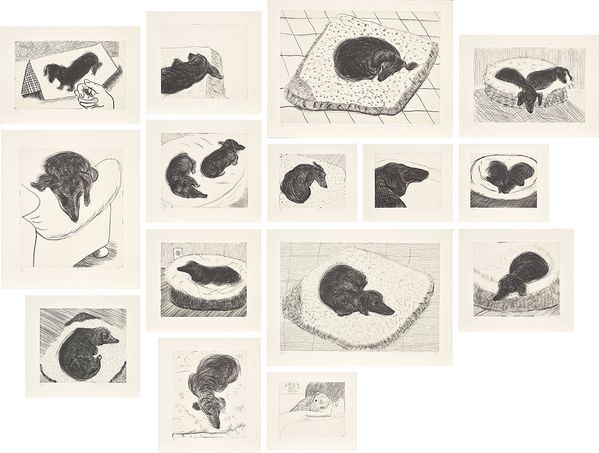David Hockney, Dog Wall, 1998. David Hockney, London.
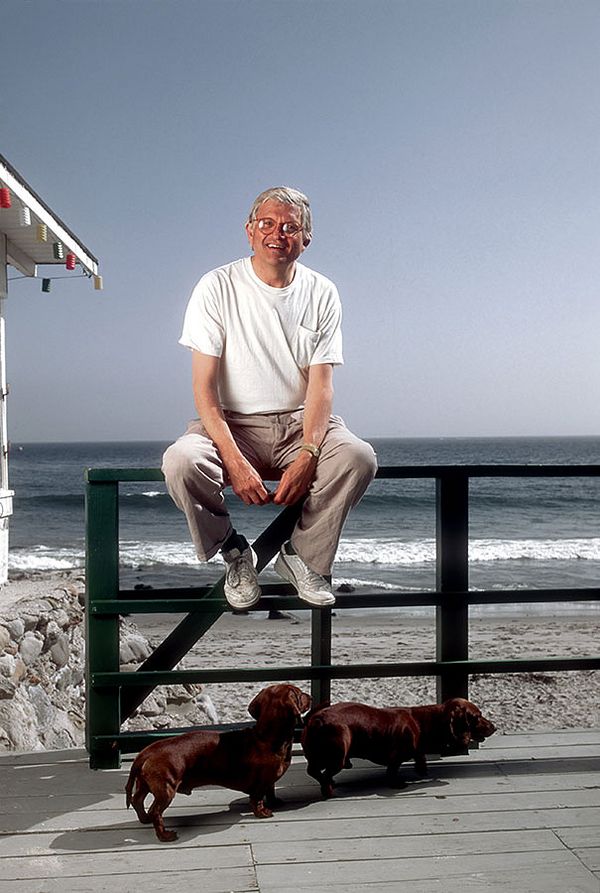
David Hockney with his dogs, August, 1991. Image: Paul Harris / Getty Images.
David Hockney, Stanley & Little Boodgie
Comprised of fifteen etchings, David Hockney’s Dog Wall is a large-scale homage to his two beloved dachshunds: Stanley and Little Boodgie. Hockney’s love for sausage dogs was first sparked by Heinz, the much-adored dachshund of his close friend Ian Falconer. After seeing how besotted Hockney was with Heinz, Falconer took the artist to the breeders to pick out Stanley, with Little Boodgie joining the artist’s household a few years later. Portraying the two dachshunds lounging in a variety of positions — sometimes together, sometimes individually — Dog Wall attests to Hockney’s adoration of Stanley and Little Boodgie while simultaneously illustrating the brilliance of his draftsmanship.
They sleep with me; I’m always with them. They don’t go anywhere without me and only occasionally do I leave them. They’re like little people to me.
—David Hockney
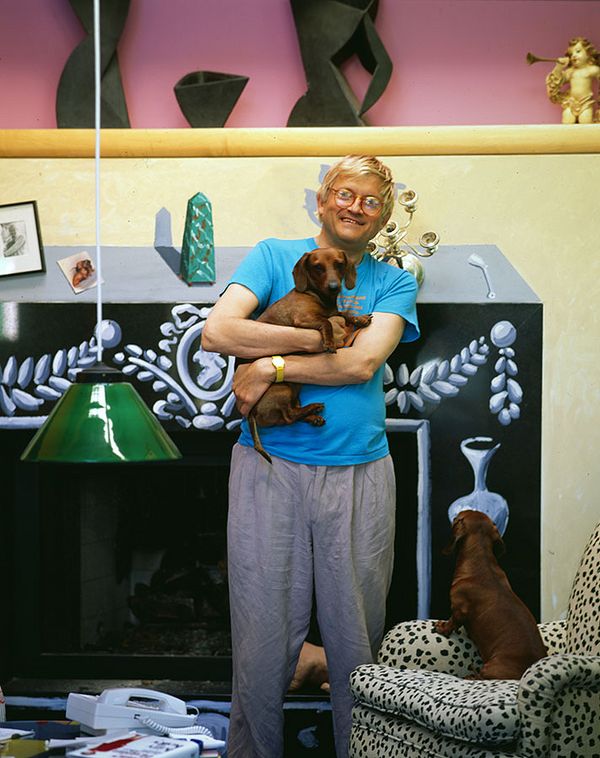
David Hockney, 1991. Image: Paul Harris / Getty Images.
Realized in 1998, the Dog Wall portfolio was produced soon after Hockney’s close friend and master printer Maurice Payne moved into the artist’s Los Angeles home for a year. In Hockney’s Montcalm Avenue residence, Payne set up a fully-functioning etching studio. He took to leaving prepared etching plates all around Hockney’s house, which the artist would then spontaneously use as he might a sketchbook. This sense of freedom is exhibited in the individual charming etchings that comprise Dog Wall, with each print serving as a quick study of the dachshunds. Captured at speed — before the dogs darted off again — Hockney uses variations in line to depict the pair as rapidly yet realistically as possible. In some prints, delicately and sporadically placed lines conjure up the face of an animal at rest, with the negative space of the unmarked surface acting as an oasis of stillness. In other etchings, densely packed lines overlap into pulsating balls of energy, adding a vitality to the prints and conveying the lively personalities of Stanley and Little Boodgie, even in the brief moments of calm that Hockney sought to capture. Dog Wall is an exquisite study in mark-making executed entirely in monochrome, and serves as a composite portrait of Hockney’s two cherished pets.
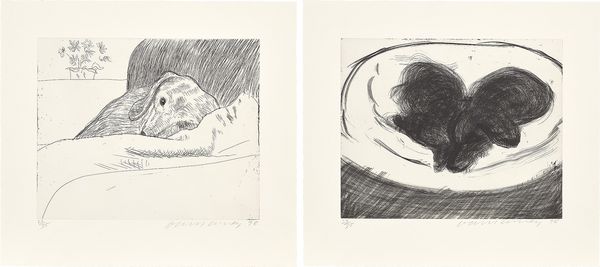
David Hockney, Dog Etching No. 11 (left) and Dog Etching No. 1 (right), from Dog Wall, 1998.
Pablo Picasso & Lump
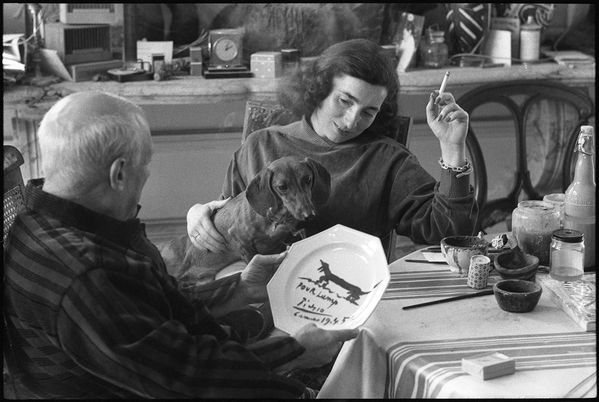
While Jacqueline Roque and Lump look on, Pablo Picasso inspects the souvenir luncheon plate he has just painted for and dedicated to Lump. Image: David Douglas Duncan / Harry Ransom Center, University of Texas.
This was a love affair. Picasso would take Lump in his arms. He would feed him from his hand. Hell, that little dog just took over. He ran the damn house.
—David Douglas Duncan
Like David Hockney, Pablo Picasso also had a beloved dachshund who featured in several of his works. On 19 April 1957, the photojournalist David Douglas Duncan visited Picasso’s Villa La Californie mansion in Cannes, France. He brought with him a little brown-haired dachshund called Lump. This was out of necessity, as the smaller dog could not be left at home with Duncan’s other pet — a much larger Afghan Hound. According to Duncan, it was as if Lump immediately decided that Picasso’s house was to be his new home, and he recalled that Picasso was equally enamoured with the little dog. In fact, Picasso would paint his first portrait of Lump that very same day. While eating lunch, Picasso asked Duncan if Lump had ever had his own plate. When Duncan responded no, Picasso picked up his brush and painted a simple portrait of Lump on his dinner plate, which he proceeded to sign and date. Attesting to his infatuation with Lump, Picasso chose to depict the dachshund while Jacqueline Roque was seated at the same table. Arguably Picasso’s most famous muse, Jacqueline found herself momentarily overlooked in favour of Picasso’s new canine companion. Although Lump would reappear in 15 of the 44 studies Picasso would make of Velázquez's Las Meninas later that year, with the little dachshund replacing the elegant hound that featured in the original painting, Jacqueline Roque retains the record as the most featured subject in Picasso’s oeuvre: over 400 of his portraits contain her likeness.
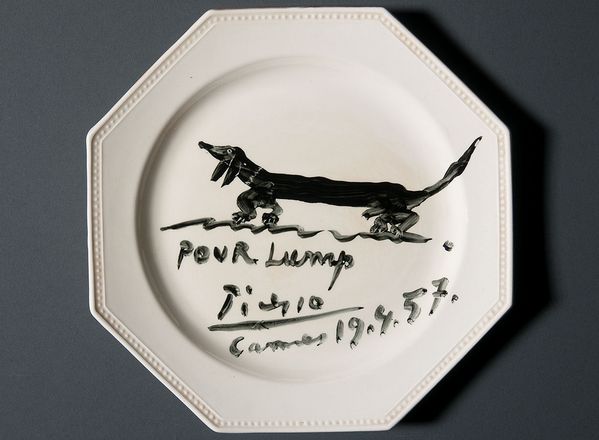
Souvenir luncheon plate painted by Pablo Picasso and dedicated to Lump. Image: David Douglas Duncan / Harry Ransom Center, University of Texas. Artwork: © Succession Picasso / DACS, London 2022.
Andy Warhol, Archie & Amos
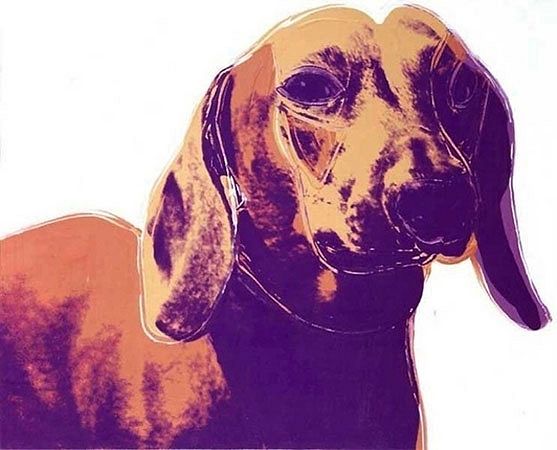
Andy Warhol, Amos, 1976. Artwork: © 2022 The Andy Warhol Foundation for the Visual Arts, Inc. / Licensed by DACS, London.
Andy took Archie to his studio, to art openings, and Ballato’s Restaurant on Houston Street… Archie was always on Andy’s lap, eating bits of food that he was handed [and] was always carefully hidden under Andy’s napkin just case a restaurant health inspector would happen to come by.
—Vincent Fremont
When we think of Andy Warhol’s muses, it is usually the artist’s vivid screenprints of Hollywood starlets like Marilyn Monroe that come to mind. However, like Hockney and Picasso, Warhol had a soft spot for animals. As a self-professed cat-lover, it took some persuasion from his boyfriend Jed Johnson for Warhol to agree to getting a dog — in the first instance, a dark-brown dachshund called Archie. Before long, the artist was besotted with the little puppy. Vincent Fremont — the manager of Warhol’s studio The Factory — recalled Archie going everywhere with Warhol. He even stated that the Pop Art master refused to travel to London, as it would mean leaving Archie behind or forcing him into quarantine.
A few years later, a light-brown dachshund called Amos joined the Warhol household to keep Archie company. Soon after the arrival of Amos, Warhol immortalized the little puppy in a series of paintings using acrylics and screenprinting. Warhol depicted the dachshund at least twelve times in early 1976, approaching Amos with the same vibrant Pop Art aesthetic that he applied to his celebrity portraits, demonstrating the high esteem in which he held the little dog. Recognizing that others were similarly enamored with their pets, Warhol identified a market for individual portrait commissions of animals. The artist went on to produce over seventy paintings and over forty drawings of dogs and cats in the mid-1970s, depicting the pets of his friends and acquaintances while also returning to both Archie and Amos as subjects multiple times. In every portrait, Warhol conveys each animal as if they were human, aiming to capture their personality through their positioning and the color palettes he carefully selected. This output — occasionally referred to as Warhol’s ‘Cats and Dogs’ series — clearly confirms the artist’s love for his own dogs, but simultaneously attests to a universal bond between owners and their pets.
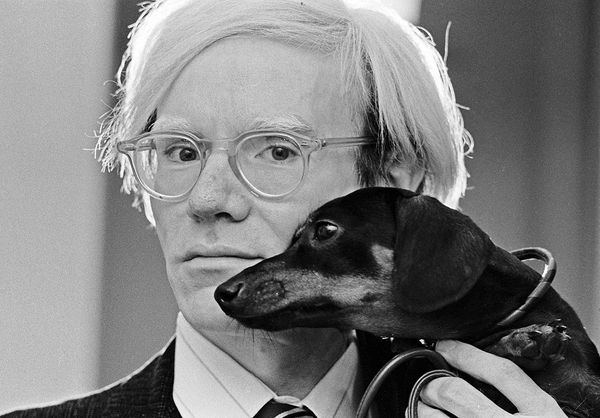
Andy Warhol poses with his beloved dachshund Archie in November 1973. Image: Tim Boxer/Archive Photos/Getty Images.
As three of the most renowned artists of the 20th century, Hockney, Warhol, and Picasso all tackled a variety of different subject matter and produced hundreds of masterpieces between them. Yet, the selection of intimate works that each artist produced of their beloved dachshunds offer unique glimpses into the personal lives of these great masters and reveal a serendipitous commonality between them. As with Warhol’s and Picasso’s renderings of their pets, David Hockney’s Dog Wall illustrates his artistic skill, but is also infused with the artist’s own personality and feelings towards his cherished dogs. Not only is the work masterfully executed, but it represents a significant aspect of Hockney’s own biography by epitomizing his relationship with Stanley and Little Boodgie.
Recommended Reading
When I First Met the Queens: Tama Janowitz on Warhol >
Joan Miró: From Venice to London >
Eternity in the Present: Whitehot’s Noah Becker on Alex Katz >
